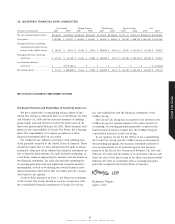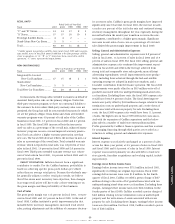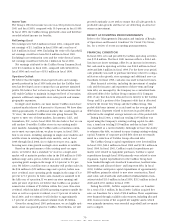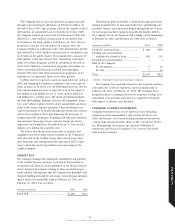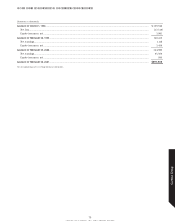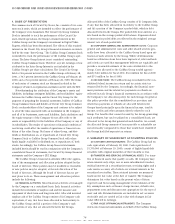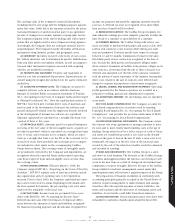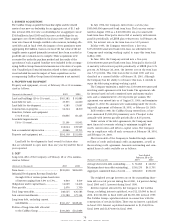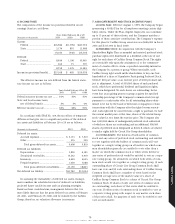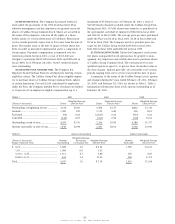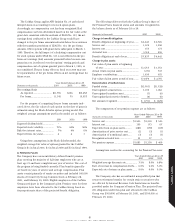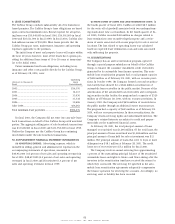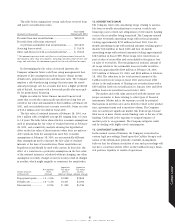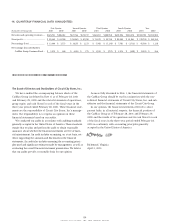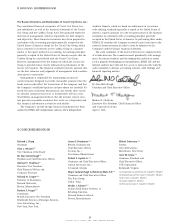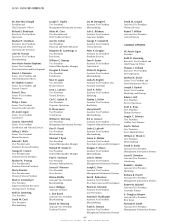CarMax 2001 Annual Report Download - page 80
Download and view the complete annual report
Please find page 80 of the 2001 CarMax annual report below. You can navigate through the pages in the report by either clicking on the pages listed below, or by using the keyword search tool below to find specific information within the annual report.
The carrying value of the Company's financial instruments,
excluding interest rate swaps held for hedging purposes, approxi-
mates fair value. Credit risk is the exposure created by the poten-
tial nonperformance of another material party to an agreement
because of changes in economic, industry or geographic factors.
The Company mitigates credit risk by dealing only with counter-
parties that are highly rated by several financial rating agencies.
Accordingly, the Company does not anticipate material loss for
nonperformance. The Company broadly diversifies all financial
instruments along industry, product and geographic areas.
(D) INVENTORY: Inventory is stated at the lower of cost or mar-
ket. Vehicle inventory cost is determined by specific identification.
Parts and labor used to recondition vehicles, as well as transporta-
tion and other incremental expenses associated with acquiring
vehicles, are included in inventory.
(E) PROPERTY AND EQUIPMENT: Property and equipment is
stated at cost less accumulated depreciation. Depreciation is cal-
culated using the straight-line method over the assets’ estimated
useful lives.
(F) COMPUTER SOFTWARE COSTS: The Company accounts for
computer software costs in accordance with the American
Institute of Certified Public Accountants Statement of Position
98-1, “Accounting for the Costs of Computer Software Developed
or Obtained for Internal Use.” Once the capitalization criteria of
SOP 98-1 have been met, external direct costs of materials and
services used in the development of internal-use software and
payroll and payroll-related costs for employees directly involved
in the development of internal-use software are capitalized.
Amounts capitalized are amortized on a straight-line basis over
a period of three to five years.
(G) INTANGIBLE ASSETS: Amounts paid for acquired businesses
in excess of the fair value of the net tangible assets acquired are
recorded as goodwill, which is amortized on a straight-line basis
over 15 years, and covenants not to compete, which are amor-
tized on a straight-line basis over the life of the covenant not to
exceed five years. Both goodwill and covenants not to compete
are included in other assets on the accompanying CarMax
Group balance sheets. The carrying values of intangible assets
are periodically reviewed by the Company and impairments are
recognized when the expected future undiscounted operating
cash flows expected from such intangible assets are less than
the carrying values.
(H) PRE-OPENING EXPENSES: Effective March 1, 1999, the
Company adopted SOP 98-5, “Reporting on the Costs of Start-Up
Activities.” SOP 98-5 requires costs of start-up activities, includ-
ing organization and pre-opening costs, to be expensed as
incurred. Prior to fiscal 2000, the Company capitalized pre-open-
ing costs for new store locations. Beginning in the month after
the store opened for business, the pre-opening costs were amor-
tized over the remainder of the fiscal year.
(I) INCOME TAXES: Income taxes are accounted for in accor-
dance with SFAS No. 109, “Accounting for Income Taxes.”
Deferred income taxes reflect the impact of temporary differ-
ences between the amounts of assets and liabilities recognized
for financial reporting purposes and the amounts recognized for
income tax purposes, measured by applying currently enacted
tax laws. A deferred tax asset is recognized if it is more likely
than not that a benefit will be realized.
(J) REVENUE RECOGNITION: The CarMax Group recognizes rev-
enue when the earnings process is complete, generally at either the
time of sale to a customer or upon delivery to a customer.
(K) DEFERRED REVENUE: The CarMax Group sells service con-
tracts on behalf of unrelated third parties and, prior to July 1997,
sold its own contracts at one location where third-party sales
were not permitted. Contracts usually have terms of coverage
between 12 and 72 months. Commission revenue for the unre-
lated third-party service contracts is recognized at the time of
sale, because the third parties are the primary obligors under
these contracts. Inasmuch as CarMax is the primary obligor on its
own contracts, all revenue from the sale of these contracts was
deferred and amortized over the life of the contracts consistent
with the pattern of repair experience of the industry. Incremental
direct costs related to the sale of contracts were deferred and
charged to expense in proportion to the revenue recognized.
(L) SELLING, GENERAL AND ADMINISTRATIVE EXPENSES: Operating
profits generated by the finance operation are recorded as a
reduction to selling, general and administrative expenses.
(M) ADVERTISING EXPENSES: All advertising costs are expensed
as incurred.
(N) STOCK-BASED COMPENSATION: The Company accounts for
stock-based compensation in accordance with Accounting
Principles Board Opinion No. 25, “Accounting For Stock Issued
to Employees,” and provides the pro forma disclosures of SFAS
No. 123, “Accounting for Stock-Based Compensation.”
(O) DERIVATIVE FINANCIAL INSTRUMENTS: The Company enters
into interest rate swap agreements to manage exposure to inter-
est rates and to more closely match funding costs to the use of
funding. Swaps entered into by a seller as part of a sale of finan-
cial assets are considered proceeds at fair value in the determi-
nation of the gain or loss on the sale. If such a swap were to be
terminated, the impact on the fair value of the financial asset
created by the sale of the related receivables would be estimated
and included in earnings.
(P) RISKS AND UNCERTAINTIES: The CarMax Group is a used-
and new-car retail business. The diversity of the CarMax Group’s
customers and suppliers reduces the risk that a severe impact will
occur in the near term as a result of changes in its customer base,
competition or sources of supply. However, because of the CarMax
Group’s limited overall size, management cannot assure that
unanticipated events will not have a negative impact on the Group.
The preparation of financial statements in conformity with
accounting principles generally accepted in the United States of
America requires management to make estimates and assump-
tions that affect the reported amounts of assets, liabilities, rev-
enues and expenses and the disclosure of contingent assets and
liabilities. Actual results could differ from those estimates.
(Q) RECLASSIFICATIONS: Certain amounts in prior years have been
reclassified to conform to classifications adopted in fiscal 2001.
77
CIRCUIT CITY STORES, INC. 2001 ANNUAL REPORT
Carmax Group


